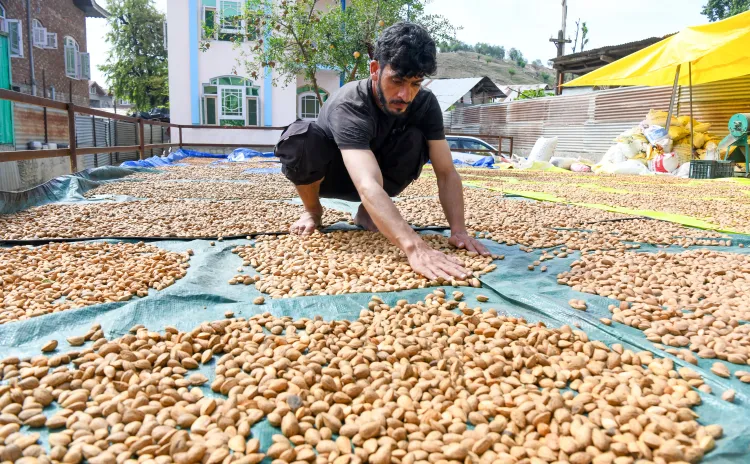How Will GST Rejig Transform J&K’s Economy?

Synopsis
Key Takeaways
- GST rate for handicrafts reduced from 12% to 5%.
- Boost for local artisans and farmers enhancing livelihoods.
- Heritage products like Pashmina shawls are now more competitive.
- Tourism sector growth supported by lower GST on hotel tariffs.
- Significant contribution of almonds to the local economy.
New Delhi, Oct 4 (NationPress) The rationalization of GST rates, decreasing from 12% to 5%, is enhancing competitiveness, reducing costs, and broadening markets in Jammu and Kashmir across sectors including handicrafts, agriculture, tourism, and local specialties.
According to an official document, this financial relief bolsters the livelihoods of artisans and farmers, promotes exports, and fosters employment, all while maintaining the region's rich cultural heritage.
Heritage items, such as GI-tagged Pashmina shawls, Dogra cheese, and Basohli paintings, are now better equipped to compete in both domestic and international markets, thus preserving their cultural identity.
With the updated GST rates, the handloom sector is now subject to a mere 5% GST. This change makes iconic products like pashmina shawls and carpets more affordable and competitive in both local and global markets.
This reduction in costs allows the entire Kashmir valley to benefit from increased demand, heightened sales, and improved exports, significantly aiding artisans and weavers who rely on these crafts for their livelihoods.
In J&K, the wicker willow handicraft—a local specialty—uses this durable material to produce various items through traditional methods. It has also gained from the GST reduction, with rates slashed from 12% to 5%.
Likewise, paper-mache, one of Kashmir’s renowned crafts and a GI-tagged traditional sector, is receiving similar adjustments at a pivotal moment as it confronts growing competition from machine-made alternatives.
The official document highlights that important craft clusters, including Srinagar, Budgam, and Ganderbal, stand to benefit greatly from the GST rate cut, which enhances competitiveness, supports artisan livelihoods, and sustains these unique cultural industries.
In the Kashmir Valley, particularly in Kanihama, nearly 5,000 weavers produce exquisite GI-tagged Pashmina shawls. The GST reduction from 12% to 5% makes these shawls more accessible, thereby enhancing demand, exports, and competitiveness against machine-made imitations while securing livelihoods and safeguarding Kashmir’s iconic heritage.
J&K produces over 91% of India’s almonds, with manufacturing and processing centers located throughout the Kashmir region.
This sector alone generates employment for around 5,500 individuals, serving as a vital component of the local economy. The Kashmiri almond packaging industry notably benefits from a substantial GST decrease.
This reduction is anticipated to stimulate demand and sales volumes, promote greater value addition within the state, and improve profit margins for both farmers and processors.
The stunning landscapes of J&K, from Jammu’s renowned temples to the serene lakes and gardens of the Kashmir Valley, position it as a premier global tourist destination.
The tourism sector supports over 70,000 jobs and contributes nearly 15% to the state’s GDP. Tourist numbers have steadily increased, rising from 2.1 crore in CY23 to 2.3 crore in CY24.
With the GST for tourism and hotel tariffs decreased from 12% to 5% for stays costing up to Rs 7,500, traveling will become more economical, boosting occupancy rates, encouraging longer stays, increasing revenue for local businesses, and further strengthening employment within the sector.









